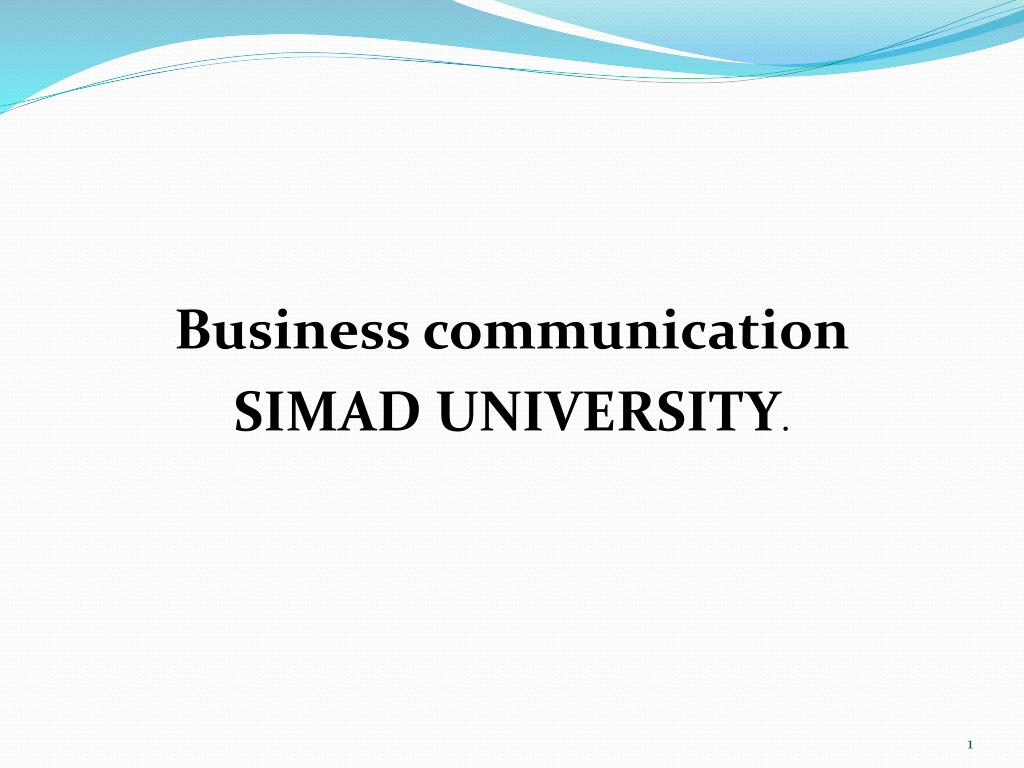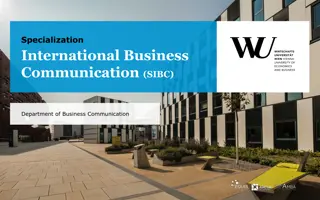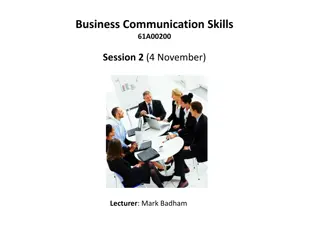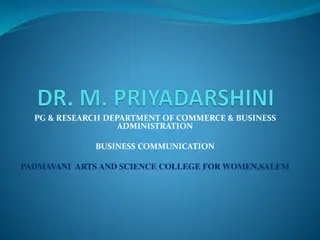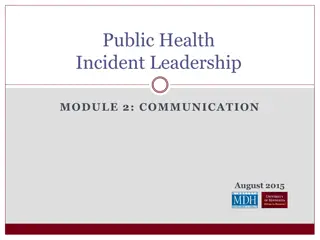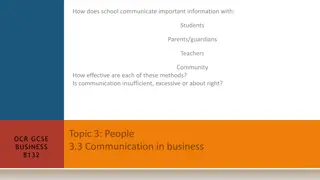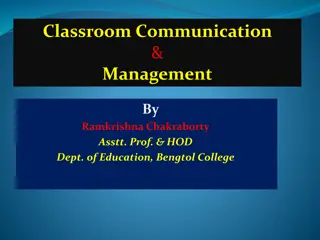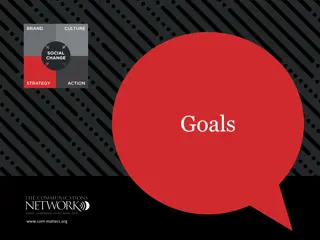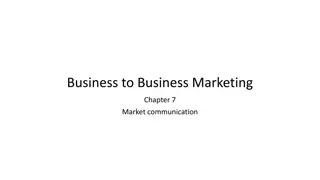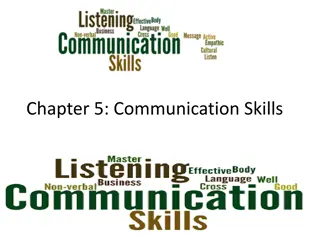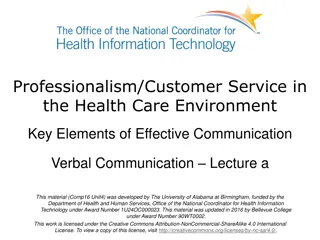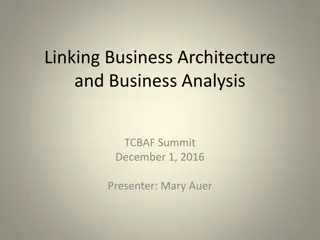Understanding Effective Communication in Business
Effective communication is crucial in business to ensure messages are understood clearly. Misunderstandings can lead to costly mistakes, as shown in a scenario where clarification was avoided due to fear of appearing foolish. Communication involves more than just words, incorporating factors like relationships and context. Learning from successes and failures can help improve communication skills and foster better relationships in the workplace.
Download Presentation

Please find below an Image/Link to download the presentation.
The content on the website is provided AS IS for your information and personal use only. It may not be sold, licensed, or shared on other websites without obtaining consent from the author. Download presentation by click this link. If you encounter any issues during the download, it is possible that the publisher has removed the file from their server.
E N D
Presentation Transcript
Business communication SIMAD UNIVERSITY. 1
Business communication The root of the word communication in Latin is communicare, which means to share, or to Communication is defined as the process of understanding and sharing meaning. make common.
I THOUGHT IT SO SIMPLE Ahmed , an artist, gives a piece of modern art to his new hire, Ali who is an unskilled assistant and a complete novice as far as fine art is concerned, asks him to put a hole at the centre. Ali understands the meaning of the word centre but he does not know the purpose of putting a hole. Being unfamiliar with modern art, he does not know whether the purpose is to hang this piece of art on a wall horizontally, vertically or upside down. The centre could also mean a point, equidistant from all four corners of the piece.
Ali could have asked Ahmed for clarification, but he does not know the mindset of Ahmed. He is hesitant to seek clarification because of the fear that his boss might think that he is stupid. Ahmed does not bother to get feedback from Ali on whether he understood it the same as he did. Finally Ali puts the hole at a wrong place and an expensive art piece is wasted, which makes Ahmed furious.
The above example is a simple case of communication which can become highly complex because of one or more of the following reasons: Communication is not just about words. Words by themselves don t have any meaning, but people have denotative and connotative. Often messages are act on the basis of implicit rather than explicit communications. It s an appropriate to get feedback before the action then after it. To cross-check the intended message. Communication is a shared process of creating meanings influenced by factors like relationships, context, purpose and individual knowledge. The meaning a person intends is not often the other one understands. Communications has to be timely, appropriate to the situation.
Effective communication An organization s lifeblood Every day we are talking to the people on the phone or in person or transcribing business correspondence, liaising with colleagues and staff, writing letters, faxes, reports, and e-mails. It s important to learn from our communications, our successes and our failures to develop our communication skills.
Definitions Communication may be defined as: giving, receiving or exchanging information, opinions or ideas by writing, speech or visual means, so that the message communicated is completely understood by the recipient.
Benefits of effective communications: Strong decision- making and problem -solving Upturn in productivity Convincing and compelling corporate materials Clearer , more streamlined work follow ( To improve the effectiveness of an organization) Enhance professional image Sound business relationships Successfully response insured
Communications in a changing work place Today sworkplace is constantly changing and developing, so effective communication is important to enable you to meet numerous challenges such as:
1-Advancing technology: The internet E-mail Fax Messages Voice mail Tele conferencing Video conferencing Wireless devices People can work together effortlessly weather they are in New York or New Zealand, Singapore, or Seattle, Beijing or Bangkok; whether they are in a car or an office.
2-Global communication Multinational companies increasing numbers of people from ethnic backgrounds 3-The information age Have quick decisions based on the information you receive To know how to find asses, process and communicate information efficiently and effectively
4-Team-based business environment The traditional management hierarchy has changed. Team working is now in vogue Have to study and understand how team-based environment work together Have to listen and watch other people carefully so that you interpret non- verbal cues you receive
Methods of communications Internal communications (oral) Telephone Messages Face to face discussions Presentations Meeting-conference Intercom Internal communication (written) Report Memo Staff newsletter Minutes Form-questionnaire Intranet Notes Faxes E-mail Graphs-charts
External communication (oral) Telephone Conversation Conference/seminar Meeting Teleconference Video conference Presentation External communication (written) Leaflet/brochure Invitation Forms/questionnaire Press release Customer newsletter Advertisement Notice Graph/chart Report E-mail Fax Letter internet
Choosing the channel of communication The channel (or means) that is chosen to send a message is very important. The channel chosen can influence the message and how it is interpreted by the recipient. Each situation should be judged individually and will depend on various factors such as: Cost Consider how much the communication will cost in terms of the result expected. Can an internal message be handwritten or is a printed copy important? Is the postal service satisfactory or is e-mail or fax justified?
Confidentiality E-mail or fax may not be appropriate. A telephone call could be overheard. An internal memo may need to be enclosed in an envelope. Safety and security Should special post office service be used? Would a courier service be justified?
Influence To convey a certain impression, would a congratulation telegram or invitation be suitable? Multicolored letterheads on high quality paper convey a good image of a company. Urgency Choose the method that will produce the desired results in the time available. The higher cost of a fax will be justified by the results obtained through its speed.
Distance Is the communication within the building; is the same town, or the other side of the world? Time of day This is particularly important when communicating with overseas countries. Resources Consider the equipment and staff available (sender and recipient).
Written record Consider who is sending/ receiving the message. Personal contact may be appropriate on certain occasions. Verbal communication may not be appropriate where complex information or bad news is concerned. Choose language appropriate; consider the situation and the relationship between sender/recipient.
Key stages in the communication cycle 1-Source (sender) The source of communication is the sender, or for our purposes, you. In order to be a good source, you need to be clear about the message that you are sending. Do you know exactly what it is that you want to communicate? You will also want to be sure you know why you are communicating. What result is that you expect? If you can t answer these questions, you will be starting the communication process with a high chance of failure.
2-Message The message is simply the information that you want to communicate. Without a message, there is no cause for communicating. If you can t summarize the information that you need to share, you aren t ready to begin the process of communication
3-Encoding Encoding is the process of taking you message and transferring in to a format that can be shared with another party. It is sort of like how messages are sent via a fax. The information on the paper has to be encoded, or prepared before it can be sent to other party. It has to be sent in format that the other party has the ability to decode or the message will not be delivered. In order to encode a message properly, you have to think about what the other person will need in order to understand or decode the message. Are you sharing all the information that is necessary to get the picture? Are there culture, environmental or language differences between you and the other party that cause miscommunication?
4- channel The channel is the method or methods that you use to convey your message. The type of message you will have help to determine the channel that you should use. Channels include face-to-face conversation, telephone calls, videoconferences, and written communication like emails and memos. Each channel has its advantages and disadvantages
5- Decoding Decoding happens when you receive the message that has been sent. The communication skills required to decode a message successfully include the ability to read and comprehend, Listen actively, or ask clarifying questions when needed. If the person you are attempting to communicate with seems to be lack the skills to decode your message, you will need to resend it again.
6-Receiver Since you have thought out your message, you have certainly also thought about it what you wanted the desired result to be on the part of your listener. But it s important to realize that each person that receives your message will be listening to it through their own individual expectations, opinions and perspectives. Their experiences will influence how you message is received.
7-Feedback No matter what channel you have used to convey your message, you can use feedback to determine how successful your communication was. If you are face-to-face with your audience, you can read body language and ask questions to ensure understanding. If you have communicated via writing, you can gauge the success of your communication by the response that you get or by seeing if the result you wanted is delivered.
Barriers to communication Communication problems Poor vocabulary or choosing words badly Pre-judgment Lack of good relationships Highly emotional about the topic concerned the sender b/w the recipient
Some Other Barriers Barriers change a message. Here are some more common barriers that can change the message. Accent Anger Background Biases Culture Tone of voice Expectations Expressions
Facial expression Fear Frowning Gesture Group pressures Individual differences Interruption Jargon Lighting Visual distraction Negotiation methods Noise personal appearance
personal space physical barriers prejudices pronunciation self-perception self-truth silence slang smell
social background smiling stress submissiveness taste temperature threatening motion
The flow of communication In small organization of just few people there may be few problems. In large organization the process is more complicated. Most large companies produce an organizationchart which makes lines of communication quite clear. organization charts make it easier to how communication can take place vertically (between levels), horizontally (between sections) and diagonally different levels and sections) communication ( between
The grapevine The term, grapevine, describes an official communication system which is constantly changing. The grapevine is a vehicle for distortions of the truth, rumor, and gossip. An active grapevine can cause much damage to an organization by spreading incomplete false information. It results in low morale, cynicism, fear and unsettled workforce. Although the grapevine may never be completely eradicated, management should take steps to reduce its influence. or exaggerated
What is culture? Culture is a shared system of beliefs, attitudes, values, expectations and norms of behavior. Members of a culture have similar beliefs and theories on how people should behave, think and communicate.
Acknowledging culture difference Many people assume that other people s attitude and lives are like our own, but this is not so. Your aim should be to try to treat people not inthe way you wish to be treated, but rather treat them the way they want to be treated. If you are to communicate effectively across culture, you must not judge other people by your own standards. It is essential to retain an open mind and remember that our own culture background is not necessarily superior to anyone else s culture.
The belief that ones own cultural background is a superior to all others isknown as ethnocentrism. This creates barriers to effective communication because the mind remains closed to new information. If you want to avoid ethnocentrism you should: Recognize cultural differences Avoid assumptions Do not prejudge
If you are to communicate effectively in a cultural diverse workforce, here are some points to remember. If you follow these tips, you will be able to communicate with anyone from any culture. Show respect. show empathy. Treat people as individuals. Do not pre-judge. Be open-minded. Avoid distractions. Be patient.
Look for similarities. Send clear messages. Recognize your prejudices. Treat people as individuals.
Seven steps To Effective communication Step-1: what and why Your first step is to consider what is the objective of your communication and why you have to communicate the message. Step-2: select channel The next step is to consider what channel should be appropriate. Step-3: select encoding technique Encoding is choosing the manner in which we send our message. for example, the language you choose, an angry or softvoice, harsh tone or courteous tone. Step-4: consider barriers you must consider all possible barriers that may influence the recipient s understanding of the message. Step-5: send message
Step-6: check for understanding after sending the message, it is important to check whether the recipient has understood the message as you intended. Step-7: obtain feedback from recipient It is essential to obtain feedback from the recipient. If the message is not understood, rather than blame the recipient, ask you self why the communication failed and how could be improved. Some questions you might ask are: Did your expression or language create confusion? was your timing poor? Was your message too long so that the main points were lost? Were your tone or manner appropriate? Didn t you structure the message logically?
The impact of information technology The task of creating documents much easier Programs are available that will produce standard layouts for most business documents. Computerexperts may not be so expert in modern display of business documents. The fundamental skills of structure, tone and composition should be ensured in effective communication No matter how technology develops in the future, high standards must be set and maintained in order to ensure appropriate worded, logical structured and attractive presented ways:
Learning objective six: making ethical communication choices Ethics: are the accepted principles of conduct that govern behavior within a society. Ethical principles define the boundary between right communication includes relevant information, is true in every sense, and is not deceptive in any way. Unethical communication can distort the truth in a variety of ways: and wrong. Ethical Plagiarism Omitting essential information Selective misquoting Misrepresenting numbers Distorting visuals Failing to respect privacy or information security needs
Distinguishing ethical dilemmas from ethical lapses Ethicaldilemma: involves making a choice when the alternatives aren t completely wrong or completely right. An ethicallapse is making a choice that you know to be unethical. Ensuring ethical communication Responsible employers establish clear ethical guidelines for their employees to follow and determine what is acceptable. This requires three elements: Ethical individuals, Ethical company leadership, and The appropriate policies and structures to support the employees efforts to make ethical choices.
Ensuring legal communication In addition to ethical guidelines, Business communication is also bound by a variety of laws and regulations in these areas: Promotional communication Contracts Employment communication Intellectual property Financial reporting Defamation
Successful communications Read Listen intelligently Think and plan Use appropriate language (use clear, simple language) Be open minded (consider other people s viewpoints) Select appropriate media Time your communication appropriately Use appropriate language (use relevant words to the topic) Obtained feedback Aim high (set and maintained high standards in all your methods of communication, both in terms of language and presentation)
Blooper and blunder (mistakes) The wrong way Alot Alittle Infact inspite of The correct way A lot A little In fact In spite of
Old-fashioned phrases Old of Above-mentioned This/These Accede to Agree with Instead
END QUESTIONS ?
